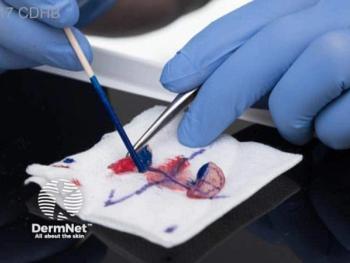
Melanoma Overdiagnosis: Awareness May Not Change Behavior
Dermatopathologists diagnose melanoma at similar rates regardless of whether they think the skin cancer is overdiagnosed.
Being aware of melanoma overdiagnosis does not appear to curtail the rate at which dermatopathologists diagnose melanomas, according to a survey published in JAMA Dermatology.1
“Our findings suggest that pathologists are aware of and care about this topic of overdiagnosis, and many of them want to be part of the solution,” senior author Joann G. Elmore, MD, MPH, told Dermatology Times. “Our hope is that pathologists will consider the problem of overdiagnosis when interpreting individual cases.”This consideration creates tension, she said, as dermatologists do not want to misdiagnose a cancer as benign.
“Yet we often respond by overdiagnosing cases,” said Elmore, professor of medicine at the University of California, Los Angeles David Geffen School of Medicine.
Investigators surveyed 115 dermatopathologistswho had participated in the previously published Reducing Errors in Melanocytic Interpretations (REMI) study.2 Using their own microscopes, participants reviewed hematoxylin-eosin-stained slides representing 90 melanocytic skin lesion cases that had elicited high diagnostic variability in a previous study.3
Topline findings are as follows:
- The proportions of respondents who agreed that atypical nevi, melanoma in situ, and invasive melanoma are overdiagnosed were 68%, 47%, and 35%, respectively.
- Dermatopathologists with less than 5 years’ experience were twice as likely as those with more than 20 years’ experience to believe that the 3 entities are overdiagnosed.
Changes in medical education probably explain the above discrepancy, said corresponding author Kathleen Kerr, professor of biostatistics at the University of Washington in Seattle. “Medical schools may have begun to discuss overdiagnosis, so that younger physicians are more likely to view overdiagnosis as a public health issue compared to those who attended medical school in the past.”
Elmore said that when she was in medical school, overdiagnosis was never mentioned. “We now have scientific data showing that there is overdiagnosis of many different diseases, and this is part of the medical school curriculum.”
Additional findings were as follows:
- Dermatopathologists who agreed that invasive melanoma is overdiagnosed called 30% of test cases invasive melanoma. The corresponding figure among those who disagreed was 27% (P = 0.44). “We found no evidence that pathologists who think invasive melanoma is overdiagnosed are more cautious in diagnosing invasive melanoma,” possibly due to healthcare providers’ tendency to blame problems on others rather than themselves,4,5 authors wrote.
- Participants who agreed that all 3 conditions are overdiagnosed diagnosed 40% of test cases as mild-to-moderate atypia, versus 36% for other participants (P = 0.08)
- Most respondents (59%) reported seeing unnecessary biopsies in their practices.
“Anecdotally,” said Kerr, “we hear stories about primary care doctors who seem too eager to biopsy skin lesions. This is reflected in our study, with a majority of dermatopathologists agreeing that they see cases in practice that probably should not have been biopsied. One piece of the solution may need to be more restraint in skin biopsies.”
Elmore added that addressing overdiagnosis also will require dermatologists to reduce unnecessary skin biopsies, and to work with pathologists to reduce variability of pathologists’ diagnostic thresholds. “Of course,” she said, “this needs to be balanced with our goal of not missing the invasive melanomas that might bring harm to our patients. This is not an easy task.”
Neither is educating patients who are perhaps too concerned about melanoma, Elmore said. “Most of my clinic patients have never heard of ‘overdiagnosis,’ and this is a challenging topic to explain. In addition, patients are very concerned about ‘cancer,’ and their perception of their level of risk is usually markedly higher than their actual risk.”
Many patients believe they need annual screening skin examinations, Elmore added, although data do not support this practice. “Discussing these topics while also educating them on what types of skin changes and appearances warrant evaluation takes time that we usually do not have in the primary care clinic setting—especially if we are also taking care of their diabetes, hypertension, elevated lipids, and obesity in the same session.”
Disclosures:
Elmore is editor-in-chief for adult primary care topics at UpToDate. Kerr reports no relevant financial interests.
References:
1. Kerr KF, Eguchi MM, Piepkorn MW, et al. Dermatopathologist perceptions of overdiagnosis of melanocytic skin lesions and association with diagnostic behaviors. JAMA Dermatol. Published online April 20, 2022. doi:10.1001/jamadermatol.2022.0489
2. Taylor LA, Eguchi MM, Reisch LM, et al. Histopathologic synoptic reporting of invasive melanoma: How reliable are the data? Cancer. 2021;127(17):3125-3136. doi:10.1002/cncr.33612
3. Elmore JG, Barnhill RL, Elder DE, et al. Pathologists' diagnosis of invasive melanoma and melanocytic proliferations: observer accuracy and reproducibility study. BMJ. 2017;357:j2813. Published 2017 Jun 28. doi:10.1136/bmj.j2813
4. Reisch LM, Carney PA, Oster NV, et al. Medical malpractice concerns and defensive medicine: a nationwide survey of breast pathologists. Am J Clin Pathol. 2015;144(6):916-922. Doi:10.1309/AJCP80LYIMOOUJIF
5. Zadro JR, Farey J, Harris IA, Maher CG. Do choosing wisely recommendations about low-value care target income-generating treatments provided by members? A content analysis of 1293 recommendations. BMC Health Serv Res. 2019;19(1):707. Published 2019 Nov 11. doi:10.1186/s12913-019-4576-1
Newsletter
Like what you’re reading? Subscribe to Dermatology Times for weekly updates on therapies, innovations, and real-world practice tips.

















